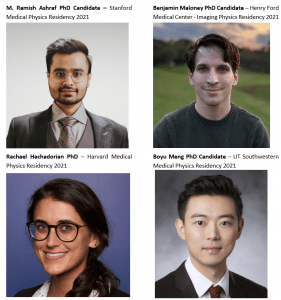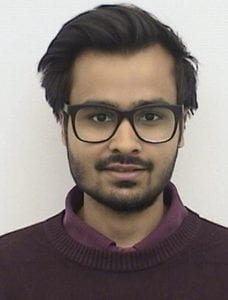The AAPM Annual virtual meeting is a forum for many students and researchers within the Dartmouth Medical Physics Education Program, and a sweep of awards show the excellence, with 6 Blue Ribbon ePosters, 1 Young Investigator Talk, 3 additional talks and 3 additional posters!
Blue Ribbon Prize ePosters
Imaging Dose in Breast Radiotherapy by X-Ray CT Calibration of Cherenkov Light
Rachael Hachadorian, et al
Session Title: Multi-Disciplinary Blue Ribbon ePoster: BReP-SNAP-M-87
Imaging Proton Pencil Beam Scans & Depth Dose Profiles with An Optimized Scintillation Screen & High Frame Rate Camera
Mahbubur Rahman, et al.
Session Title: Therapy Blue Ribbon ePoster: BReP-SNAP-T-77
Total Skin Electron Therapy Treatment Planning and Dose Distribution Verification Using Cherenkov Imaging and Computer Animation Techniques
T Miao, et al
Session Title: Multi-Disciplinary Blue Ribbon ePoster: BReP-SNAP-M-141
High Resolution Optical Imaging of 4 & 5 Millimeter Beams: A Small Field Dosimetry Technique
Muhamad Ashraf, et al
Session Title: Therapy Blue Ribbon ePoster: BReP-SNAP-T-74
Real Time Plan Verification of Radiotherapy Treatment Plans Using Couch and Gantry Mounted Cameras
Muhumad Ashraf, et al,
Session Title: Therapy Blue Ribbon ePoster: BReP-SNAP-T-119
Rapid commissioning of an MR-Linac with Hydrostatic and Cherenkov Imaging Techniques
Rongxiao Zhang, et al
Session Title: Multi-Disciplinary Blue Ribbon ePoster: BReP-SNAP-M-123
Talks
First-time imaging of Light Generation in the Eye During Radiotherapy
Irwin Tendler, et al
Session Title: John R. Cameron YOUNG INVESTIGATOR SYMPOSIUM
Session Number: MO-CD-TRACK 1-2
First Imaging of Intrinsic Light Emission from Biological Tissue Visualized Proton Pencil Beam Scanning
P Bruza, et al,
Session Title: Imaging for Particle Therapy
Session Number: MO-E-TRACK 2-3
Date: 07/13/2020 Session Time: 03:30PM - 04:30PM
Scintillation Imaging for 2D Beam Characterization and Output Measurement for MR-Linac Quality Assurance
D Alexander, et al,
Session Title: MRI in Radiotherapy
Session Number: TU-EF-TRACK 2-14 (last number indicates order within session)
Date: 07/14/2020 Session Time: 03:30PM - 05:30PM
Treatment Verification from Cherenkov Imaging During Radiation Therapy
B Pogue, et al,
Session Title: Thunder and Light(ning): Applications and Potential of Radiation Acoustics and Optics
Session Number: SU-CD-TRACK 3-5
Date: 07/12/2020 Session Time: 01:00PM - 03:00PM
ePosters
Evaluating the Clinical Utility of Cherenkov Imaging in Radiotherapy
R Hachadorian, et al,
Session Title: Multi-Disciplinary General ePoster
Poster Number: PO-GeP-M-194
Automated Detection of Field Match Lines Between Supraclavicular and
Tangent Irradiation Fields with Cherenkov Imaging
R Hachadorian, et al
Session Title: Multi-Disciplinary General ePoster PO-GeP-M-75
Estimated Linear Energy Transfer and Depth Dose Profiles Through Combined Radioluminescence Imaging & Monte Carlo Calculation
M Rahman, et al,
Session Title: Therapy General ePoster: PO-GeP-T-388
Efficient Acquisition of MR-Linac Commissioning Data Using Cherenkov Projection Imaging
D Alexander, et al,
Session Title: Multi-Disciplinary General ePoster PO-GeP-M-183







